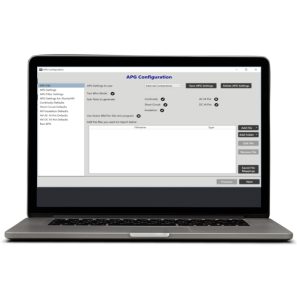What is the APG in MK Test’s MKAT software?

APG stands for Automatic Program Generation. It’s an acronym you’ll hear throughout your MKAT training and is at the heart of our MKAT software. This article – written by MK Test’s Sales Director Jason Evans – explains how APG works and what it does.
What is APG?
In short, APG is the simplest method of creating test programs for continuity, insulation, shorts and HiPot (dielectric withstand) as well as full component functional testing. Everything that is tested by an MK Test Automeg system can be described in a ‘From – To’ table. A wire might be routed from Connector A Pin 1 to Connector B pin 1. The route through a component such as a relay might be described as from Relay X terminal 1 to Relay X terminal 2.
History of APG
Many years ago, MK Test Systems changed the way the industry created test programmes by moving away from needing to create a script in a customized programming language that required test engineers to be specialist “programmers”.
We created the ‘Netlist Table’ concept, whereby the test planner simply fills in the from and to fields in a netlist table and enters the test type and current/voltage/resistance fields. The test programme format is the same common from-to netlist format that the harness shop uses to build the harness.
Nobody describes a harness in coded script to the person building that harness, we simply deliver a table describing the end points/connections, and a drawing. Why should the test programme be any more complicated than that connections table?
How does APG work?
APG makes use of the fact that the product to be tested is invariably described in a connections table, or netlist.
In order to test a harness and deliver effective test reports, the test system needs two pieces of information:
- The netlist of the harness being tested
- The cross reference connection table describing how the harness is connected to the Automeg test system. We call this interface the XRef (for cross reference).

APG basics
In it’s simplest form the APG tool allows the user to import 2 tables, typically in csv or similar format – the netlist and the Xref. The system then combines these two tables, and depending on a series of tick-box options will create a test sequence of three tests: continuity resistance test, low voltage short circuit test, and high voltage insulation resistance test. This process takes a matter of seconds.
A third table of test parameters (current, voltage and resistance) can be imported and those parameters automatically applied, or the APG tool can apply default values that are preset by the user.
Importantly, the APG tool does not rely on these netlist and XRef tables being in any specific format. It allows the user to configure and save a “map” that describes the contents of each column within the user’s data set.
If the user has different data sets with different content formats, the user can save a map per data set. This is typical for a harness shop that receives netlist data from multiple customers and projects.
This ability to configure maps, by dragging and dropping headers within the APG tool, means the APG tool is uniquely flexible and there is no reliance on MK Test Systems for costly re-designs or reconfiguration of the APG tool.
APG for assemblies with internal connections
The second level of APG that is included in the MK toolset allows the system to resolve routes through complex assemblies with internal connections.
The customer’s from-to data might describe the routes to and from internal connections, mating connectors or terminal blocks that cannot be accessed by the test system.
The APG tool allows the user to define “mating address rules” whereby the system is able to recognize that the to and from addresses actually describe an internal connection; it then continues to resolve the route until an external “accessible” end point is reached. Often the customer spends many hours resolving these internal connections to feed into a test system. The MK APG tool resolves these routes automatically and instantly; saving time, money and eliminating the potential for errors in defining routes in the test programme.
APG for assemblies including active components
The final level of APG included in the standard MK toolset enables the automatic creation of test programmes for complex assemblies that include active components. It includes the creation of function tests for those components.
To make use of this level of APG, the user will load the component library with the characteristics of the components used in their product. Those characteristics include:
- The connections that exist across the component in its passive state
- The stimulus required to acuate that component
- The connections and resistance values across that component in its actuated state.
These components will be referred to in the user’s netlist. When the APG tool identifies an address in the input netlist that refers to a component, it interrogates the Component Library to resolve the route through that component and out to an accessible interface address.
The system also interrogates the stimulus requirement, creates a subtest that will actuate the component, and applies the routes through the component in its actuated state and out to an accessible interface address.
Importantly, APG recognizes the need to actuate components that occur in series and will analyse and apply the most efficient sequence to tests to ensure that each component and combination of components is tested effectively.
Summary and benefits
Each of these three levels of Automatic Program Generation is available as standard, at no extra cost, within the MKAT test management software suite. The APG toolset is designed to be easily configured by the user to suit their own input data format. APG offers rapid test program generation and eliminates manual programming errors.
This is not a new tool. In 2006 MK Test received an award from BAE Systems F35 for reducing their test program generation time from a forecast of 4 months to less than 1 hour!
Today, we estimate that around 70% of MK users are using our APG tool, saving time and maximizing test efficiency.
Next steps
You can download a PDF version of this article here.
For an overview of MKAT software, visit the product page here. For more useful ‘how to’ and help articles, head to our blog and filter by ‘FAQ’. If you’re an existing customer and would like some help with APG, visit our training page to find your best option.
